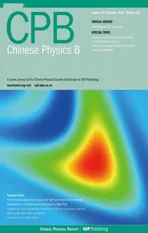Phase matched scanning optical parametric chirped pulse amplification based on pump beam deflection∗
2021-10-28RongYe叶荣HuiningDong董会宁XianyunWu吴显云andXiangGao高翔
Rong Ye(叶荣) Huining Dong(董会宁) Xianyun Wu(吴显云) and Xiang Gao(高翔)
1College of Physics and Engineering,Chengdu Normal University,Chengdu 611130,China 2College of Science,Southwest University of Science and Technology,Mianyang 621010,China
Keywords: optical parametric chirped pulse amplification,optical beam deflection,phase matching,scanning,KTN crystal
The broadband phase matching is still a problem that has not been solved well for optical parametric chirped pulse amplification (OPCPA), although the peak power of ultra-short laser pulse has been increased to terawatt (TW, 1012W),petawatt (PW, 1015W) and even exawatt (EW, 1018W) in virtue of the OPCPA,whose focused intensity is near to 1023–1024W/cm2.[1–4]There is no denying that the OPCPA is the preferred technology to output PW high power pulse at present. And in recent years, high average power, kinds of parametric crystal and multi-wavelength regions from visible to near-infrared, even mid-infrared have been widely demonstrated around the world.[5–7]Although the bandwidth of the signal pulse in spectral domain wider and the compressed duration shorter such as few-cycle in time domain, the limited gain bandwidth cannot ensure that it is phase matched for each frequency component of the signal pulse. And some research indicate that the intrinsic phase-mismatch induces the optical parametric phase which degrades the bandwidth of the amplified signal pulse.[8]To further enhance the phase matching and amplified bandwidth, some measures have been explored, for instance, achromatic phase or quasi-phase matching OPCPA.[9–11]Actually, too much operation to the signal pulse is undesired because the tilted pulse front or wave front caused by dispersion elements may induce the beam quality variation and so on. However,the OPCPA,predictably,is becoming most widely used in the whole table,high-power and high-energy ultra-short laser pulse system step by step.
2. Theoretical basis of phase-matched scanning OPCPA
In the second order nonlinear optical effects of OPCPA,the weak signal pulse obtains amplified energy from the robust pump pulse, and this process produces addition idler pulse.Generally, the chirped signal pulse whose frequency shows linear change with time is broadened from ultra-short laser pulse by stretcher. Although there are two main geometry schemes, i.e., collinear and non-collinear optical parametric amplification, the second one is widely adopted inasmuch as the interactional three waves leave from the nonlinearity crystal in different directions without any splitting system and the group velocity of the three pulse is easier matched in a large wavelength range in the non-collinear amplification. The efficiency of parametric conversion usually depends on the phase matching which is also known as the conservation of momentum in optics. The gain and conversion efficiency is the highest when the three waves are phase matched completely and the amplified signal spectrum is wide enough to support the compressed ultra-short durations for Fourier transform limited pulse. Though the parametric amplification is also capable in the case of three coupling waves phase-mismatched,the gain and conversion efficiency will decrease obviously. By ignoring the vertical mismatch on the premise of small noncollinear angle,the phase-mismatching ∆kalong the pumping direction is

wherekj(j=p, s, and i refers to the bump, signal and idler pulse,respectively)is the wave-vector. The non-collinear angleαis the angle between the pump wave-vector and the signal wave-vector,which is linked withβbetween the pump and idler wave,described as

Actually, for broadband signal range, ∆k=0,<0 or>0 is all possible which depends on the signal wavelength, noncollinear angle, and phase-matching angleθm. The phasematching angleθmis the angle between the pump beam and the optical-axis,expressed as

wherenopandnepare the main refractive indexes of pump light in crystal,supposed type-I(ep=os+oi)parametric amplification.
We take theβ-BaB2O4(BBO)crystal as an example. For the central 800 nm wavelength signal pumped by 532 nm,the absolute phase-matching angleθm0supporting ∆k=0 are approximately 26.85°and 29.34°, with the non-collinear angleα0=4°and 5°correspondingly. However, the actual signal pulse has a certain bandwidth, and namely it is difficult to achieve the whole phase matching on the condition of constant geometric angleθm0.
According to the above discussion, the contour plots of the phase-mismatching ∆k, signal wavelengthλsand phasematching angleθmare illustrated in Fig. 1(a). There are two contour lines, thin and thick, which are plotted with different central phase-matching angleθm0and corresponding central non-collinear angleα0for more intuitively. Firstly, it is obvious that different signal wavelength occurs different phasemismatching ∆kwith variableθm. Secondly, for the sake of phase matching of each signal wavelength,exclusiveθmis essential to support the phase-matching ∆k=0 line. Furthermore,from the characteristics of the ∆k=0 line we note that the neededθmvaries almost linearly with signal wavelength in near 100 nm wide range, which suggests the angle changing rateDθmis equivalent to the slope of the phase-matching line.Last but not least,for broadband phase matching as shown in Fig.1(b)the non-collinear angleαalso changes synchronous withθm,but the angleγbetween signal beam and the opticalaxis of crystal is constant 22.85°and 24.34°for the thin and thick contour lines, respectively, i.e., the direction of signal beam does not change and is invariable throughout the amplification.
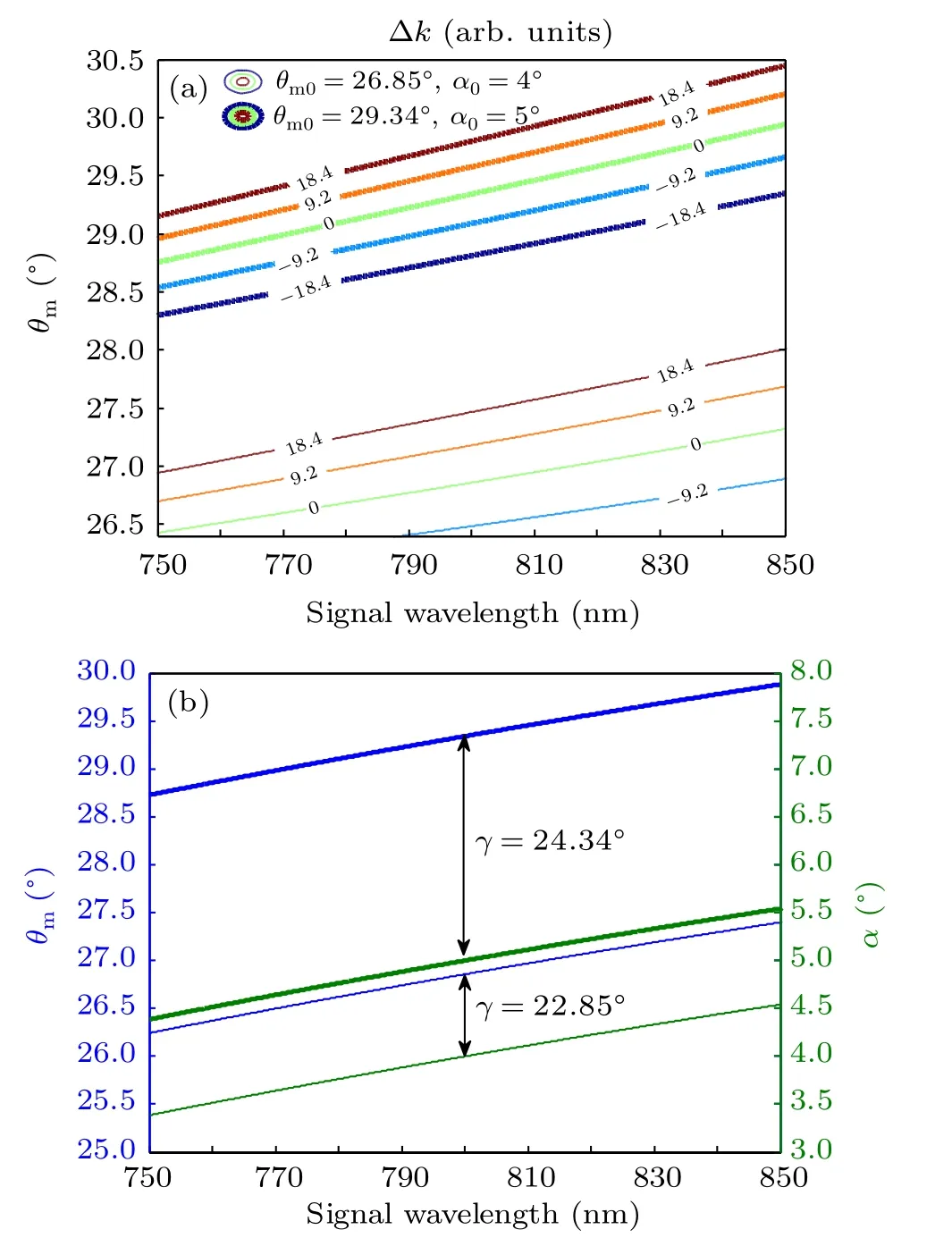
Fig. 1. (a) The contour plots of the phase-mismatching ∆k, signal wavelength λs and phase-matching angle θm. The thin and thick contour lines are presented with different central phase-matching angle θm0 and central non-collinear angle α0. (b)Variation of θm and α with signal wavelength in the best phase matching performance where γ =θm −α.
From the above discussion, it is feasible to enable each signal wavelength phase matching whenever possible by deflecting the pump beam with time for the purpose of entering into the nonlinear crystal with variationalθm. And the geometry relationship of three wave-vectors phase matching is depicted in Fig.2(a). It illustrates that the wave-vector of signalks, pumpkpand the corresponding idlerkiform a vector triangle always when the pump beam deflects with time to satisfy the neededθm. Figure 2(b) is the block diagram view of the scanning OPCPA based on the pump beam deflection.The chirped signal pulse propagates in a changeless direction,and remains the angleγunchanged. The pump pulse deflects in space with time by passing through a KTN crystal, which is applied voltage in the signal pulse duration. The variation ofθmwith time is synchronous with it of signal wavelength,which makes for broadband phase matching and maximum amplified spectrum.

Fig. 2. (a) The phase-matching vector graph for non-collinear OPCPA in control of deflecting pump beam. (b) Schematic drawing of the scanning OPCPA based on pump beam deflection.
The cubic crystal KTN(KTa1−xNbxO3,potassium tantalate niobate) has excellent electro-optical properties, and its quadratic electro-optic coefficient is one of the largest among the known crystals. After the first successful experiment and mechanism exploration of optical deflection in KTN crystal based on the quadratic electro-optical effect, kinds of optical beam splitter, optical switch, multi-dimensional scanning and ns magnitudes response have been designed and implemented.[12–15]According to the previous analysis of phase matching issues,the deflected angle of pump beam transits KTN crystal,which is put on voltage in the proposed scanning OPCPA,is given as below:[16]

whereLanddare the length and thickness of the crystal,respectively.n0represents the linear refractive index,si jis the Kerr constant of the crystal, and often equals to 1.0×10−14m2/V2. Becauseθmvaries almost linearly with signal wavelength in a broadband range by inspection of Fig. 1, the deflected angle changing rateDθmis defined as

which is exactly the slope of ∆k=0 line. Invoking the needed∆θm,it follows from Eq.(4)that the driving voltageUapplied to the crystal can be written in the form

Generally, in a moving coordinate system the coupled wave equations of type-I OPCPA in BBO crystal are written as[17]
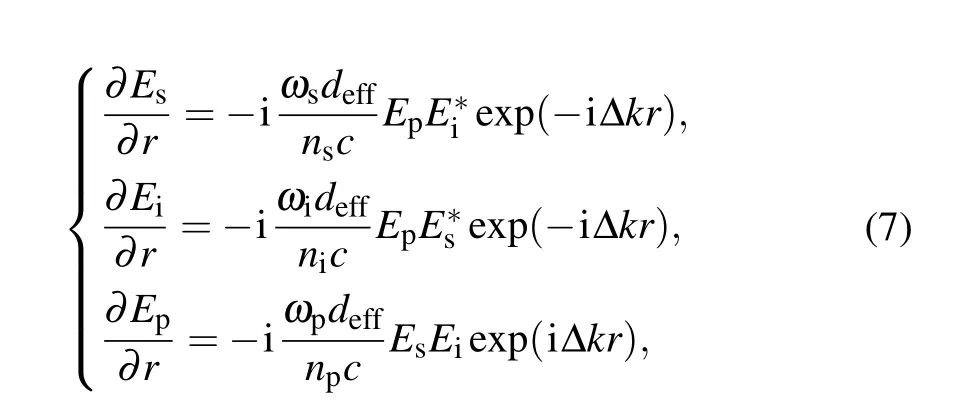
whereEj(j=p, s, i)is the electric field of three waves with second order nonlinear action.njandωj(j= p, s, i) refer to the refractive index and frequency of each pulse in the medium, respectively.deffis the second-order effective nonlinear coefficient.
3. Numerical simulation and discussion of scanning OPCPA
Taking into account the amplification of the signal and pump both as Gaussian pulses,the split-step Fourier and fourth order Runge–Kutta method are used to transform the mathematical model into a discrete simulation model, by using MATLAB2014a simulation software to simulate Eq.(7)’s dynastic performance. In this simulation, resulting of similar features, a specific case of centralθm0=29.34°corresponding toα0=5°for signal center wavelengthλs0=800 nm is provided to show the scanning OPCPA with pump deflection.The length of nonlinear BBO crystal and deflection KTN crystal isLBBO=1.22 mm,andLKTN=40 mm,respectively. The linear chirped coefficientCsof the signal pulse is 21230 corresponding to bandwidth approximately 20 nm, and the deflected angle changing rateDθm=0.0115°/nm. In addition,the signal pulse durationTws=1 ns with the peak intensityI0s=0.1 MW/cm2and assuming monochromatic wavelengthλp=532 nm of pump pulse whose pulse durationTwpis 2 ns with peak intensityI0p=1 GW/cm2.
Figure 3 shows the amplified temporal profile and the spectral distribution of signal with proposed scanning OPCPA in comparison to that without it. The initial chirped signal pulse shows Gaussian distribution whenever in time or frequency domain,and its bandwidth is almost 20 nm(FWHM).It is observed that after the traditional amplification of fixed phase matching angle, usuallyθm0, the waveform and spectrum of chirped signal are both narrowed, which is mainly caused by the phase-mismatching except the central wavelength. In contrast, on the strength of scanning OPCPA the amplified temporal profile and spectral distribution of signal pulse exhibit a good agreement with the initial ones, and it almost remains the original bandwidth unchanged under the aegis of phase matching of each signal wavelength. In addition, the conversion efficiency of the scanning amplified mode is approximately 27%in excess of the conventional 3%.This reflects the fact that it is entirely possible to broaden the phase matching bandwidth greatly and improve the gain of signal pulse adequately by means of scanning OPCPA based on pump deflection.

Fig.3. Comparison of the amplified signal pulse waveform in time domain and frequency spectrum with the conventional and scanning amplification.(a)Temporal profile. (b)Spectral distribution.
In order to achieve the above-mentioned scanning OPCPA,the KTN crystal needs to be applied with an appropriate driving voltage,and the variation of the voltage with time is shown in Fig.4(a). The pump beam deflects in space after passing through KTN crystal, and its deflection angle makes the most of phase matching ∆k=0 of each frequency component of chirped signal pulse, as the dashed line shown in Fig.4(b). From the solid line perspective, the farther the offcenter wavelength is, the larger the phase mismatch increase.That is because the fixed and just one phase-matched angleθm0contents phase matching of the central wavelength only,resulted in different phase mismatching for other signal wavelength.
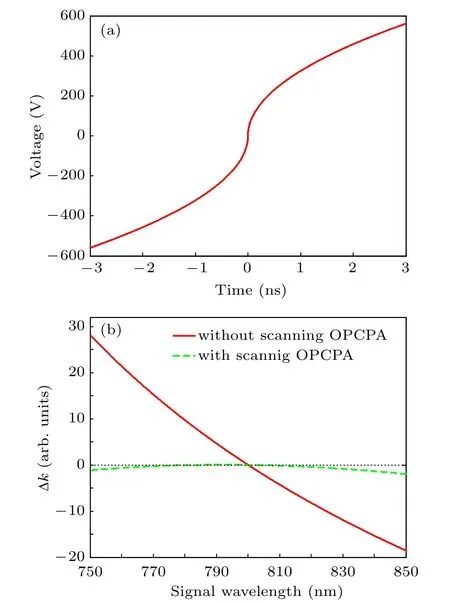
Fig.4. The required voltage for pump beam deflection for scanning OPCPA and the comparison of phase mismatching with signal wavelength in the case of varied deflection θm and fixed constant θm0. (a) Required voltage.(b)Comparison of phase mismatching.
Figure 5 demonstrates the impact of unavoidable imperfection of actual driving voltage on the performance of scanning OPCPA. Obviously, as a result of the voltage deviation,the pump’s deflected angle escapes from the optimal phase matching angle, which results in the distortion of amplified spectral distribution after the scanning OPCPA,and the greater the voltage deviation, the more serious the distortion is, as shown in Fig. 5(a). Furthermore, it is depicted in Fig. 5(b)that with the increasing of voltage deviation the energy extraction of signal from pump, i.e., the conversion efficiency decreases,whose main reason is the phase mismatching of each signal wavelength also caused by the voltage deviation. Accordingly to this end of obtaining amplified signal with better waveform,larger bandwidth and higher conversion efficiency,it is necessary to minimize the voltage deviation as much as possible. The voltage pulse applied to the KTN crystal can be generated by any waveform generator.[18,19]The low energy signal pulse from the beam splitter can pass through the time delay line and then trigger the arbitrary waveform generator through the photodetector. In order to ensure the matching of variable voltage and deflection angle of pump light, the high precision time synchronization control technology is needed,and the time synchronization accuracy can reach the several picoseconds order, which can basically meet the needs of ns pulse amplification.[20,21]
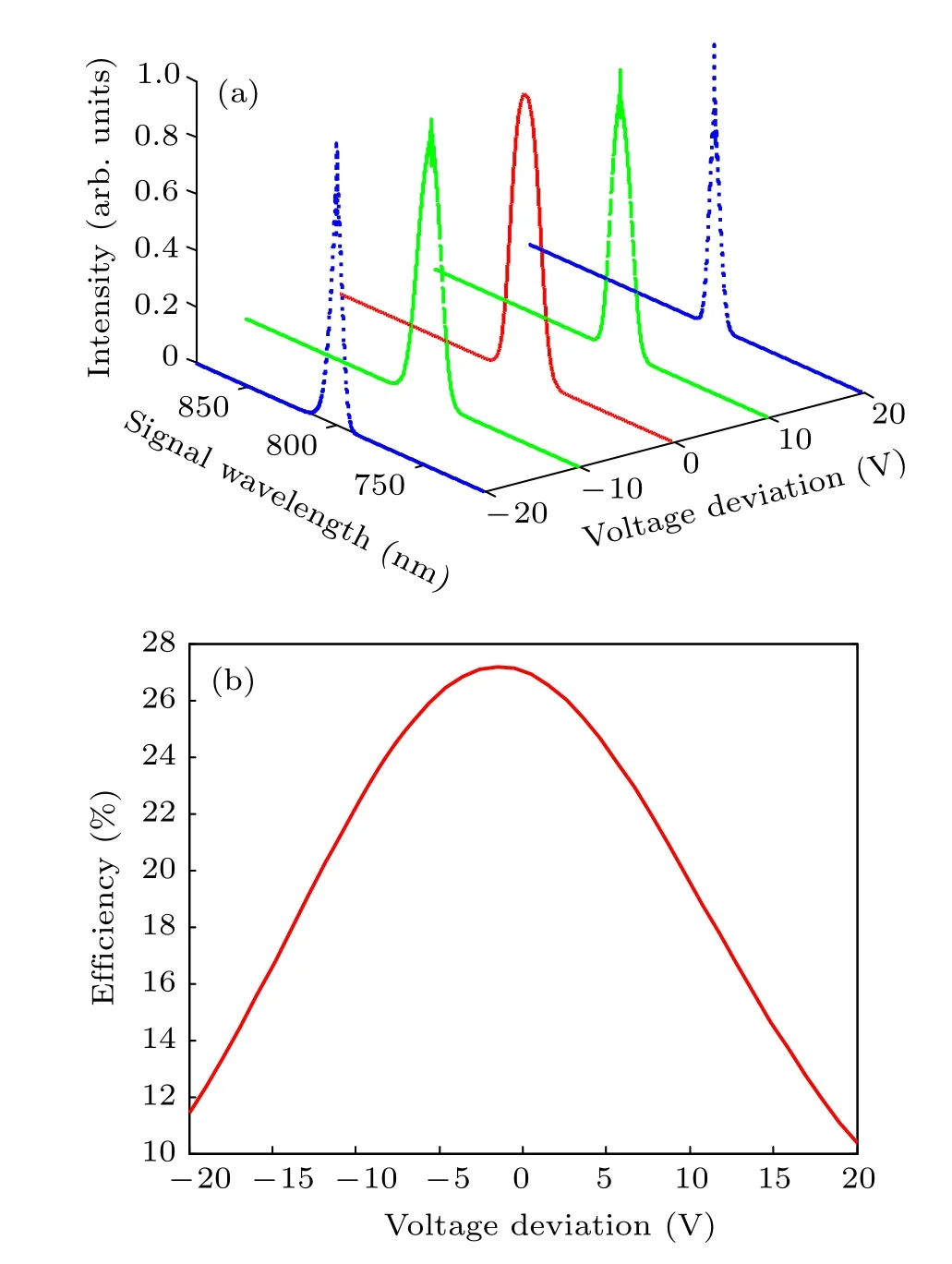
Fig. 5. The effect of voltage deviation on amplified signal spectrum and conversion efficiency after scanning OPCPA.(a)Signal spectrum evolution and(b)conversion efficiency with the voltage deviation.
4. Conclusions
In conclusion, the phase matching is the critical factors of OPCPA, and we first propose a novel scheme that broadens the bandwidth of phase-matched OPCPA combined with optical beam deflection. In this scheme, the chirped signal pulse propagates in a changeless direction,and there is no superfluous operations to it. The pump pulse are deflected in space with time by passing through a KTN crystal which is applied with varied driving voltage. By virtue of the deflection of pump beam, the phase matching angleθmis synchronous with the variation of signal wavelength in time domain,which provides broadband phase matching,spectral distribution and higher conversion efficiency.The amplification of chirped signal with 800 nm central wavelength and 20 nm bandwidth pumped by 532 nm is simulated. The results demonstrate that the amplified temporal profile and spectral distribution of signal pulse exhibit a good agreement with the initial ones, and it almost remains the original bandwidth unchanged by using of the scanning OPCPA based on the pump deflection. And it is worth minimizing the voltage deviation as much as possible for better waveform, larger bandwidth and higher conversion efficiency of amplified signal pulse.
猜你喜欢
杂志排行
Chinese Physics B的其它文章
- Physical properties of relativistic electron beam during long-range propagation in space plasma environment∗
- High winding number of topological phase in non-unitary periodic quantum walk∗
- Widely tunable single-photon source with high spectral-purity from telecom wavelength to mid-infrared wavelength based on MgO:PPLN∗
- Control of firing activities in thermosensitive neuron by activating excitatory autapse∗
- Adaptive synchronization of chaotic systems with less measurement and actuation∗
- Dynamics analysis of a 5-dimensional hyperchaotic system with conservative flows under perturbation∗
